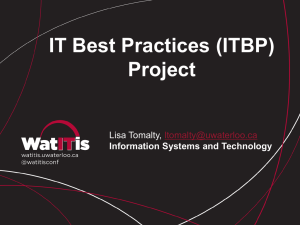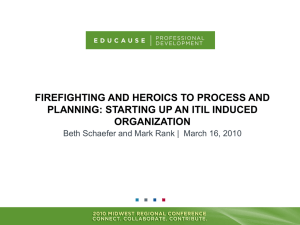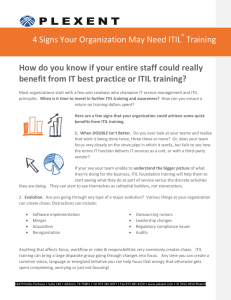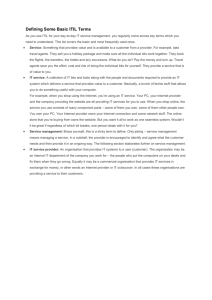ITIL V3 Foundation Exam Sample Questions
advertisement
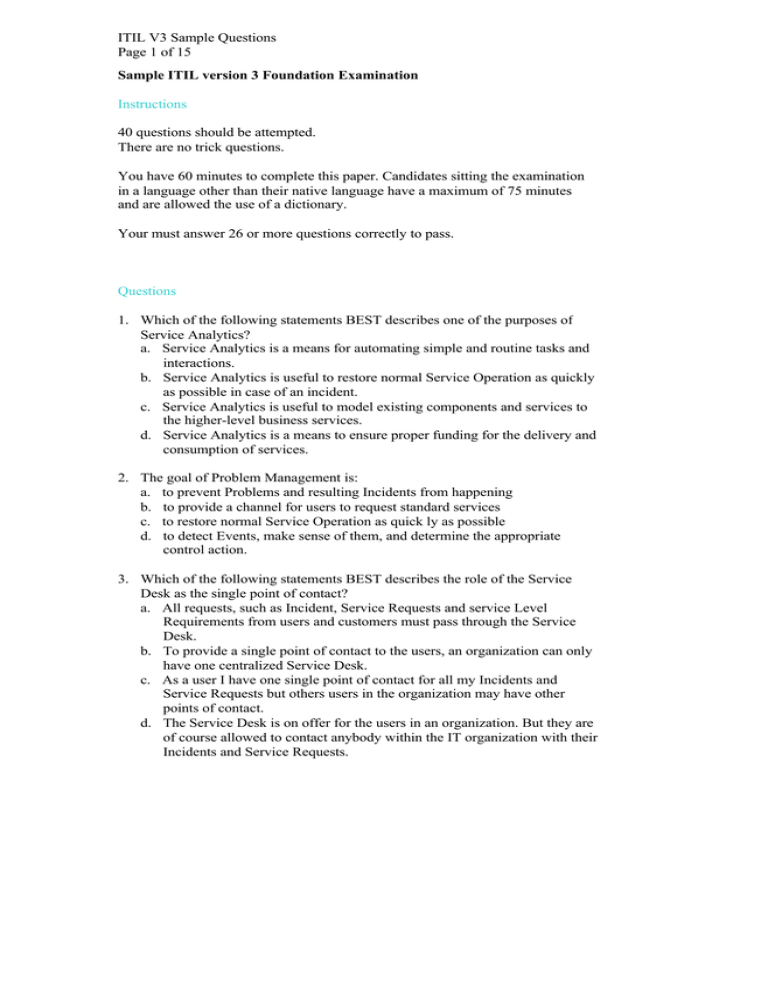
ITIL V3 Sample Questions Page 1 of 15 Sample ITIL version 3 Foundation Examination Instructions 40 questions should be attempted. There are no trick questions. You have 60 minutes to complete this paper. Candidates sitting the examination in a language other than their native language have a maximum of 75 minutes and are allowed the use of a dictionary. Your must answer 26 or more questions correctly to pass. Questions 1. Which of the following statements BEST describes one of the purposes of Service Analytics? a. Service Analytics is a means for automating simple and routine tasks and interactions. b. Service Analytics is useful to restore normal Service Operation as quickly as possible in case of an incident. c. Service Analytics is useful to model existing components and services to the higher-level business services. d. Service Analytics is a means to ensure proper funding for the delivery and consumption of services. 2. The goal of Problem Management is: a. to prevent Problems and resulting Incidents from happening b. to provide a channel for users to request standard services c. to restore normal Service Operation as quick ly as possible d. to detect Events, make sense of them, and determine the appropriate control action. 3. Which of the following statements BEST describes the role of the Service Desk as the single point of contact? a. All requests, such as Incident, Service Requests and service Level Requirements from users and customers must pass through the Service Desk. b. To provide a single point of contact to the users, an organization can only have one centralized Service Desk. c. As a user I have one single point of contact for all my Incidents and Service Requests but others users in the organization may have other points of contact. d. The Service Desk is on offer for the users in an organization. But they are of course allowed to contact anybody within the IT organization with their Incidents and Service Requests. ITIL V3 Sample Questions Page 2 of 15 4. Which of the following statements about the Process Owner role are CORRECT? 1. Every person involved in a process is a Process Owner. 2. The Process Owner is responsible for ensuring that the process is meeting the aims of the process definition. 3. The Process Owner and Process Manager roles are always undertaken by the same person. 4. Process Ownership is always a role as well as a function in any organization. a. 2 only b. 2 and 3 only c. 2, 3 and 4 only d. All of the above. 5. Which of the following is NOT an activity in the Change Management process? a. Review the Request for Change b. Plan updates c. Change Design d. Assess and evaluate change 6. Which of the following are goals and objectives for the Service Level Management process? 1. To provide and improve the relationship and communication with the business and customers. 2. To produce and maintain an appropriate and up-todate Capacity Plan which reflects the current and future needs of the business. 3. To ensure that proactive measures to improve the levels of service delivered are implemented. 4. To support efficient and effective business and Service Management processes by providing accurate information about assets. a. 1 only b. 1 and 3 only c. 1, 2 and 3 only d. All of the above. 7. Which of the following metrics types is NOT a typical type of metrics? a. Technology metrics b. Service Metrics c. Baseline metrics d. Process metrics ITIL V3 Sample Questions Page 3 of 15 8. Which of the following validation activities BEST corresponds to the definition of customer and business requirements (level 1 in the Service V-model? a. Validate Service Packages, offerings and contracts b. Service operational readiness test c. Service Release Package test d. Components and assembly test. 9. Which of the following statements BEST describes the difference between an Operational Level Agreement and an Underpinning Contract? a. Only the Operational Level Agreement is an underpinning agreement between an IT Service Provider and another part of the same organizations that assists with the provision of services. b. Only the Operational Level Agreement defines the goods or services to be provided and the responsibilities of both parties. c. Only the Underpinning Contract defines targets and responsibilities that are required to meet agreed Service Level Targets in a service Level Agreement. d. Only the Underpinning Contract supports the IT Service Provider’s delivery of IT services to customers 10. Which of the following goals are the primary goals for Service Operations? 1. To allow for changes and improvements. 2. To design processes for the operation of IT services. 3. To achieve effectiveness and efficiency in the delivery and support of services. 4. To maintain stability. a. 3 only b. 3 and 4 only c. 1, 3, and 4 only d. All of the above. 11. Which of the following is the CORRECT definition of Service Management? a. Service Management is a set of specialized organizational resources for providing value to customers in the form of services. b. Service Management is a set of specialized organizational resources for providing value to customers in the form of goods and products. c. Service Management is a set of specialized organizational capabilities for providing value to customer sin the form of services. d. Service Management is a set of specialized organizational capabilities for providing value to the Service Provider in the form of goods and products. ITIL V3 Sample Questions Page 4 of 15 12. Consider the following types of technological support of Service Management and the corresponding descriptions? A Technology-assisted B Technology-facilitated C Technology-mediated D Technology-generated (self-service) 1. The Service Provider is represented entirely by technology. 2. The service Provider and the customer are not in physical proximity. 3. Only the Service Provider has access to the same technology. 4. Both the Service Provider and the customer have access to the same technology. a. A-3, B-1, C-2 and D-4 b. A-1, B-2, C-3 and D-4 c. A-3, B-4, C-2 and D-1 d. A-4, B-3, C-2 and D-1 13. Which of the following is NOT described as a function but as a process in the ITIL Service Management Practices framework? a. Technical Management b. Service Portfolio Management c. Service Desk d. Applications Management. 14. Which of the following roles may be involved in the Continual Service Improvement process? 1. The Continual Service Improvement Manager 2. The customer 3. The Service Manager 4. The Process Owners a. 1 only b. 1 and 3 only c. 1, 3, and 4 only d. All of the above. ITIL V3 Sample Questions Page 5 of 15 15. Which of the following statements BEST describes prioritization in the Incident Management process? a. Prioritization is determined by the urgency of the Incident and the level of impact the Incident is causing. b. Prioritization is determined by the resources available and the level of impact the Incident is causing. c. Prioritization is determined by the resource available and the urgency of the incident. d. Prioritization is determined by the resources available, the urgency of the Incident and the level of impact the Incident is causing. 16. Which of the following questions is NOT one of the 7 Rs that must be answered for all changes as part of the impact assessment? a. What RESOURCES are required to deliver the change? b. Who RAISED the change? c. What is the RELATIONSHIP between this change and other changes? d. Who is going to REVIEW the change when it has been implemented? 17. The BEST way to define the services in the Service Portfolio is to base the definitions on: a. The resources needed to deliver the service b. The business outcome of the service c. The capabilities needed to delivery the service d. The composition of the service 18. Which of the following statements is the CORRECT description of the “ACT” stage in the Deming Cycle for quality improvement? a. At this stage goals and measures are established. b. At this stage the implemented improvements are compared to the measures of success. c. At this stage it is determined to keep the status quo, close the gap or add necessary resources. d. At this stage a project to close identified gaps is developed and implemented. 19. Which of the following questions helps identifying what a customer values? 1. Who is out customer? 2. Who depends on out services? 3. How does the customer use out services? 4. What do we provide? a. 1 only b. 1 and 3 only c. 1, 2 and 3 only d. All of the above. ITIL V3 Sample Questions Page 6 of 15 20. The goal of Continual Service Improvement is BEST described as: a. To continually align and re-align IT services to the changing business needs by identifying and implementing improvements to IT services that support business processes b. To encourage Service Providers to stop and think why something is to be done before thinking how c. To continually identify and implement d. To design services that satisfy business objectives. 21. Which of the following are generic elements of a process? 1. Process Activities 2. Process policy 3. Process roles 4. Process metrics. a. 1 only b. 1 and 3 only c. 1, 3 and 4 only d. All of the above. 22. Which of the following statements are CORRECT regarding the RACI authority matrix? 1. The “R” in RACI stands for “responsible”. 2. The RACI chart shows the activities down the lefthand side and the functional roles across the top. 3. More than one person can be accountable for each takes. 4. The “I” in RACI stands for “initiator”. a. 1 only b. 1 and 2 only c. 1, 2 and 3 only d. All of the above. 23. Which of the following is NOT an activity that IT Operations Management is responsible for? a. Console management b. Management of facilities c. Output management d. Maintenance of a stable technical infrastructure. 24. Assume that IT Operations is separated from Technical and Application Management. Which of the following roles does Technical an Application Management normally NOT play in the Event Management process? a. Participating in the instrumentation of the services. b. Testing the services to ensure that Events are properly generated. c. Ensuring that any auto responses are defined. d. Monitoring Events. ITIL V3 Sample Questions Page 7 of 15 25. Which of the following statements are CORRECT about Service Asset and Configuration Management? 1. Configuration Management delivers a logical model of the services, assets and the infrastructure. 2. Information about each Configur ation Item is recorded in a configuration record in the Configuration Management Systems. 3. The Service Knowledge Management System includes the Configuration Management Systems and databases, as well as other tools and databases. 4. Status Accounting and Reporting is an activity in the Service Asset and Configuration Management process. a. 1 only b. 1 and 2 only c. 1, 2 and 3 only d. All of the above. 26. Which of the following statements BEST describes the goals of Supplier Management? 1. To ensure that underpinning contracts and agreements with suppliers are aligned to business needs and managed through their lifecycle. 2. To manage relationships wit suppliers. 3. To ensure that the information security risks are appropriately managed and enterprise information resources are used responsibly. 4. To maintain a suppler policy and a supporting Supplier and Contract Database. a. 1 only b. 1 and 2 only c. 1, 2 and 4 only d. All of the above. 27. Which of the following activities BEST helps an organization managing and developing Service Management as a strategic asset? 1. Identification of critical services across the Service Portfolio for a given customer or market space. 2. Establishment of the right mix of services to offer to customers. 3. Tagging all service assets with the name of the services to which they add service potential. 4. Creation of diagnostic scripts for diagnosis of Incidents. a. 1 only b. 1 and 2 only c. 1, 2 and 3 only d. All of the above. ITIL V3 Sample Questions Page 8 of 15 28. A key role for Service Operation is to achieve a balance between conflicting sets of priorities. A fundamental conflict exists between IT and a set of technology components on one side and: a. The view in which the organization focuses only on business requirements and the services delivered b. The ability to respond to change without impacting on other services c. A strong focus on delivering quality d. Proactive behaviour on the other side. 29. When should a Service Design Package be produced? a. During the strategy stage, for each time a new service is added to the Service Portfolio. b. During the design stage, for each change to a service or removal of a service. c. When a new or changed service is passed from Service Design to Service Transition d. During the design stage, for each new service, major change to a service or removal of a service. 30. Which of the following benefits is NOT primarily the result of good Service Design practices? a. Reduce total cost of ownership b. More effective Service Management processes c. Increased success rate of changes and releases for the business. d. Improved quality and consistency of service 31. ITIL is BE characterized as: a. An international standard b. Good practice scheme c. A qualification scheme d. Academic research. 32. Which of the following activities is the Service Owner of a specific service responsible for? 1. Representing the service in Change Advisory Board meetings. 2. Participating in negotiating Service Level Agreements 3. Defining the process strategy 4. Liaising with the appropriate Process Owners. a. 1 only b. 1 and 2 only c. 1, 2, and 4 only d. All of the above ITIL V3 Sample Questions Page 9 of 15 33. Which of the following is the CORRECT order of the activities in the 7-Step Improvement Process (first activity first)? a. 1-Define what you should measure. 2-Define what you can measure. 3Gather data. 4-Process data. 5-Analyse data. 6-Present information. 7Implement corrective action. b. 1- Define what you can measure. 2-Define what you should measure. 3Gather data. 4-Analyse data. 5-Process data. 6-Present information. 7Implement corrective action. c. 1-Define what you should measure.2-Define what you can measure. 3Gather data. 4-Analyse data. 5-Process data. 6-Present information. 7Implement corrective action. d. 1-Define what you can measure. 2-Define what you should measure. 3gather data.4-Process data-5-Analyse data. 6-Present information.7Implement corrective action. 34. Which of the following methods is NOT a deployment approach? a. Big-bank b. Phased c. Pull d. Request. 35. Which of the following activities forms part of the Service Portfolio Management process? 1. Analyse 2. Define 3. Approve 4. Charter. a. 1 only b. 1 and 2 only c. 1, 2, and 3 only d. All of the above 36. To answer the question “where do we want to be?” in the Continual Service Improvement model, we need to know: 1. The vision of the organization 2. The mission of the business 3. The current baseline 4. The metrics. a. 1 only b. 1 and 2 only c. 1, 2, and 3 only d. All of the above ITIL V3 Sample Questions Page 10 of 15 37. Good Service Design is dependent on effective and efficient use of the four Ps – people, processes, partners and: a. Plans b. Products c. Practices d. policies 38. Which is the best description of a Service Catalogue? a. A document defining all aspects of an IT Service and its requirements through each stage of its lifecycle. b. The complete set of services that are managed by a Service Provider c. A database or structured document with information about all live IT services, including those available for deployment. d. An agreement between an IT Service Provider and the IT customer(s). 39. Which of the following statements are CORRECT about utility and warranty? 1. Utility can be described as what the customer gets. 2. Warranty can be defined as “fitness for use”. 3. Utility increases the average performance. 4. Warranty reduces the variation in performance. a. 1 only b. 1 and 2 only c. 1, 2, and 3 only d. All of the above 40. The Service Portfolio is the single integrated source of information on the status, interfaces and dependencies of each service used by activities within the following stages in the Service Lifecycle: 1. Service Strategy 2. Service Transition 3. Service Design 4. Service Operation a. 1 only b. 1 and 2 only c. 1, 2, and 3 only d. All of the above ITIL V3 Sample Questions Page 11 of 15 Answers: (explanations of answers is detailed later in this document) 1c 2a 3c 4 a 5c 6b 7c 8a 9a 10 c 11 c 12 c 13 b 14 d 15 a 16 d 17 b 18 c 19 c 20 a 21 d 22 b 23 d 24 d 25 c 26 c 27 c 28 a 29 d 30 c 31 b 32 c 33 a 34 d 35 d 36 c 37 b 38 c 39 d 40 d ITIL V3 Sample Questions Page 12 of 15 Detailed explanation of correct answers: 1 c – Option (a) is an objective for Event Management (b) is an objective for Incident Management and (d) is an objective for Financial Management 2 a – Option (b) is a goal for Request Fulfillment, (c) is a goal for Incident Management and (d) is a goal of Event Management 3 c – Single point of contact is seen from the user’s perspective. Option (a) is incorrect because customer requests such as Service Level Requir ements normally go to a Business Relationship Manager, A Service Level Manager or similar. Option (b) is incorrect because different users can contact different Service Desks as long as each user has only one single contact point. Option (d) is incorrect because single point of contact is also means to ensure that all user requests are logged and tracked by a dedicated function. 4 a - (statement 2 is correct) 1) is not true as Only the person responsible for the process as a whole is the Process Owner; 3) the Process Owner and Process Manager (i.e. Incident Manager) can be the same person, but is not always the same person (therefore the 3 statement is not correct); and 4) Process Ownership is always a role but is not necessarily implemented as a function in the organization. 5 c – There is no activity in the Change Management proc ess for managing individual changes called “Change Design”. 6 b – Option 2 is an object for Capacity Management and option 4 is an object for Service Asset and Configuration Management. 7 c – Baselines are markers or starting points for later comparisons of measurements. 8 a – Option (b) corresponds to level 3 (define service Solution), option (c) corresponds to level 4 (define Service Release) and option (d) corresponds to level 5 (develop Service Solution). 9 a – Option (b), (c) and (d) are true for both types of agreements. 10 c – Option 2, design of processes, is a goal for Service Design. 11 c – Service Management is a set of specialized organizational capabilities for providing value to customers in the form of services. ITIL V3 Sample Questions Page 13 of 15 12 c - no explanation provided 13 b – Service Portfolio Management is described as a process, whereas Technical Management, Service Desk and Application Management are described as functions in the Service Operation volume. 14 d – Not only all the internal roles in the Service Provider organization but also the customers should be involved in Continual serviced Improvement. 15 a – The resources available are not determining the prioritization of the Incident. Constraints to resources are the reason to do the prioritization. 16 d – The review and close of the change is not part of the impact assessment. 17 b – An outcome-based definition of services ensures that the organization plans and executes all aspects of Service Management entirely for the perspective of what is valuable to the customer. 18 c - Option (a) is a description of the “Plan” stage. Option (b) is a description of the “Check” stage and option (d) is a description of the “Do” stage. 19 c – Knowledge of the service Provider’s current services does not help identify what a customer values. 20 a – Option (b) is a goal of Service Strategy, option (c) focuses on technological developments instead of the business needs and the supporting IT services, and option (d) is an objective for Service Design. 21 d – All of the stated elements form part of a process as well as procedures, work instructions, triggers, inputs, output, capabilities etc. 22 b – More than one person can be responsible for each task but only one person can be accountable for each task. “I” stands for “Informed”. 23 d – Technical Management, not IT Operations Management, is responsible for planning, implementing and maintaining a stable technical infrastructure. 24 d – Where IT Operations is separated from Technical and Application Management, IT Operations is commonly delegated the Event monitoring and first-line response activities. 25 d – All of the statements are true about Service Asset and Configuration Management. ITIL V3 Sample Questions Page 14 of 15 26 c – Even though it is important to manage information security risks for data and services managed by third parties (option 3), this is a responsibility for the Information Security Management process. 27 c – Options 1, 2, and 3 are all part of the activities involved in developing Service Management as a strategic asset within the Service Strategy Management process. Option 4 improves the Service Management processes but not necessarily as a strategic asset. 28 a – The other options are counterparts of stability, cost and reactive behaviour, respectively. 29 d – The Service Design Package should be produced during the design stage for new, changed and removed services. A Service design package is normally only produced for major changes. 30 c – An increased rate of success of changes and releases is first and foremost a result of good Service Transition practices. The (a) total cost of ownership is reduced as a result of well-designed services, processes and technology, (b) more effective processes are a result of processes designed with optimal quality and cost effectiveness and (d) improved quality and consistency of service are the result of services designed within the corporate strategy, architecture and constraints. 31 b – ITIL is an example of good practice. (a) ISO/IEC20000 provides a formal standard for organizations seeking to have their Servic e Management Capabilities audited and certified, (c) the IT Service Management certifications and diplomas owned by OGC and managed by APGM form an example of a qualification scheme and (d) there are good examples of academic research supporting and/or criticizing ITL but ITIL itself is not academic research. 32 c – Defining the process strategy is a responsibility of the Process Owner, whereas the service Owner is responsible for the three other activities. 33 a – not additional explanation is provided 34 d – A deployment method called “Request” does not exist in ITIL. Option (a) is where the new or changed service is deploy ed to all user areas in one operation, (b) is where the service is deployed to a part of the user base initially and this operation is repeated for subsequent parts of the user based, and (c) is here the software is available in a central location but users are free to download the software at a time of their choosing. 35 d – All of the activities are port of the Service Portfolio Management process. ITIL V3 Sample Questions Page 15 of 15 36 c – The answer to the question - “Where do we want to be?” involves measurable targets, which are the prerequisites for defining the metrics. We therefore only need to know the vision, mission, goals, objectives and baseline to answer the questions. 37 b – Good Service Design is dependent on all four answers but the last “P” in the “four Ps” stands for “Products”. 38 c – The others are definitions of (a) a Service Design Package (b) a Service Portfolio and (d) a Service Level Agreement. 39 d – All of the statements are true for utility and warranty. 40 d – The Service Portfolio acts as the connection point or the “spine” of all five stages in the Service Lifecycle.


